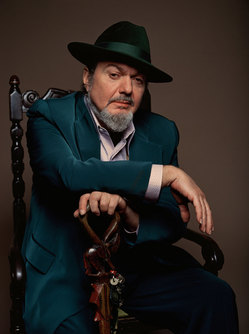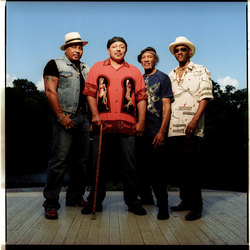Dr. John and Neville Brothers taking the Michigan Theater stage Wednesday
The Mardi Gras bash that comes to town on Wednesday may be a "day late," technically speaking. But of all of the Mardi Gras-themed events in the area that week, it will have the most righteous musical pedigree.
That’s because the Mardi Gras Mambo mini-tour that stops at the Michigan Theater on Wednesday — technically, Ash Wednesday, the day after Mardi Gras day (a.k.a. “Fat Tuesday) — showcases 2 acts that have come to represent New Orleans music possibly more than any others: the Neville Brothers and Dr. John (with his band, The Lower 911).

Dr. John
Lisa Houlgrave
It's been over 40 years since Dr. John first planted his flag as an eccentric New Orleans music innovator. He released his first LP, “Gris-Gris” — an album notable for its wholly unique mix of ominous psychedelia and bayou voodoo-man lore — in 1968. And his classic “Dr. John's Gumbo,” from ’72, still stands out as one of the definitive New Orleans R&B piano records of the last half-century. The next year, he even had a major pop hit with "Right Place Wrong Time."
Ever since, he’s been asserting his spot in the pantheon of great New Orleans R&B piano players like Professor Longhair, Huey “Piano” Smith, Fats Domino and James Booker: The Doctor, both onstage and in the studio, has continued to deliver rousing celebrations of New Orleans-style R&B, swamp-funk, rocking blues and, occasionally, zydeco — all driven by his syncopated, second-line piano rhythms. At the same time, he’s also demonstrated his facility with straight rock 'n' roll, pop-funk and jazz standards.
The Nevilles, meanwhile, are still regarded as New Orleans’ “first family of funk” — a rep earned on the strength of the infectious, similarly syncopated grooves that have propelled so many of their songs over the years.
PREVIEW |
“I feel like Ann Arbor is really lucky that it was one of cities selected for this tour, because they aren’t doing very many dates,” says Robin Graubarth, a night manager at The Ark, which is sponsoring the show with the Michigan Theater. (Indeed, according to the Nevilles’ web site, there are only 11 dates on the Mambo mini-tour.)
Graubarth has a stronger connection to, and feel for, the music of New Orleans than most Ann Arborites: She grew up in New Orleans and continues to return to the Crescent City on a regular basis, visiting family and soaking up the city’s music and culture. That includes frequent pilgrimages to the New Orleans Jazz and Heritage Festival.
“Both Dr. John and the Nevilles are just iconic masters of New Orleans music,” says Graubarth. “When I think of New Orleans music, their names are the first ones that come to mind.”

Neville Brothers
Image courtesy WME Entertainment
Although they didn’t record their first record together as the Neville Brothers until 1977, the Nevilles’ roots in the city’s music scene go back a lot farther. Oldest brother Art formed the Hawketts in the ‘50s when he was just a teenager, and co-founded legendary N.O. funk unit The Meters in the mid-‘60s. And Aaron had a smash hit in 1966 with “Tell it Like It Is.”
Graubarth says she has seen the Nevilles “a countless number of times. What strikes me most about them is their longevity and their versatility. They do everything from the chants to the funk to the more spiritual songs” — not to mention the ballads that Aaron Neville sings, employing the angelic, swooning voice that has captured many female hearts over the decades.
“And, in a way, I think people really respond to their music on an emotional, even spiritual, level.”
The last few years, it’s almost impossible to think of New Orleans music without thinking of it in the context of New Orleans being decimated, and nearly destroyed, by the flooding after Hurricane Katrina struck the city in ’05.
Dr. John (a New Orleans native who’s been living in New York since the ‘80s) was especially outraged over the Bush administration’s excruciatingly slow response to the city’s devastation, not to mention the interminably slow rebuilding of the city. That process has been marked by accusations of greed, sweetheart deals, corruption, indifference and/or willful inertia on the part of some of those who either awarded or received contracts to rebuild the city.
Dr. John — whose real name is Mac Rebennack — responded in ’08 with an album, “City That Care Forgot.” Some tunes are angry, while others are mournful, bluesy laments for a city that many feel will never be the same. And a few tracks, like “Land Grab” (which skewers those who would profit from the city’s misery) drive home the funk with passion and verve. The disc features several guest stars, most notably Eric Clapton, who lends his biting but eloquent blues-guitar sound to three tracks. Other guests are Willie Nelson, acclaimed trumpet player Terrence Blanchard, zydeco singer Terrance Simien, and Ani DiFranco.
“Dr. John has also played a vital role in the history of New Orleans music,” says Graubarth, “He’s a virtuoso piano player, and he’s so distinctive — no one else sounds like him, which I find exciting. When he’s playing, you can really hear a sense of place in his music. And his band is just great. You couldn’t ask for a better band when it comes to playing that mix of R&B, swamp-funk, zydeco and blues that he does.
“This is one of those shows where both bands will really get people up and moving. Growing up in New Orleans, where so much of the music is so rhythmic, I always love to see that.”
Kevin Ransom, a free-lance writer who covers music for AnnArbor.com, first wrote about both Dr. John and the Neville Brothers in 1991, for the Ann Arbor News. He can be reached at KevinRansom10@aol.com.


Comments
mike from saline
Fri, Feb 12, 2010 : 9 a.m.
I saw the Doctor in the early 70s at the "Ann Arbor Blues and Jazz Festival" [72, I think]. He came on in the evening, [with his fan- tastic band, and back up singers]. They played every cut from the "Gris Gris" album. It was the 1st time I'd ever seen him, or heard this dark, dangerous music. To this day, I count it as one of the best [if not THE BEST!] live music performance's I.ve ever seen.